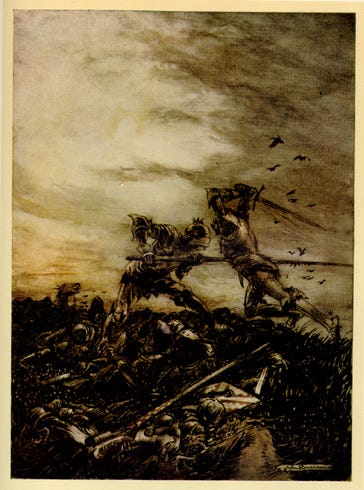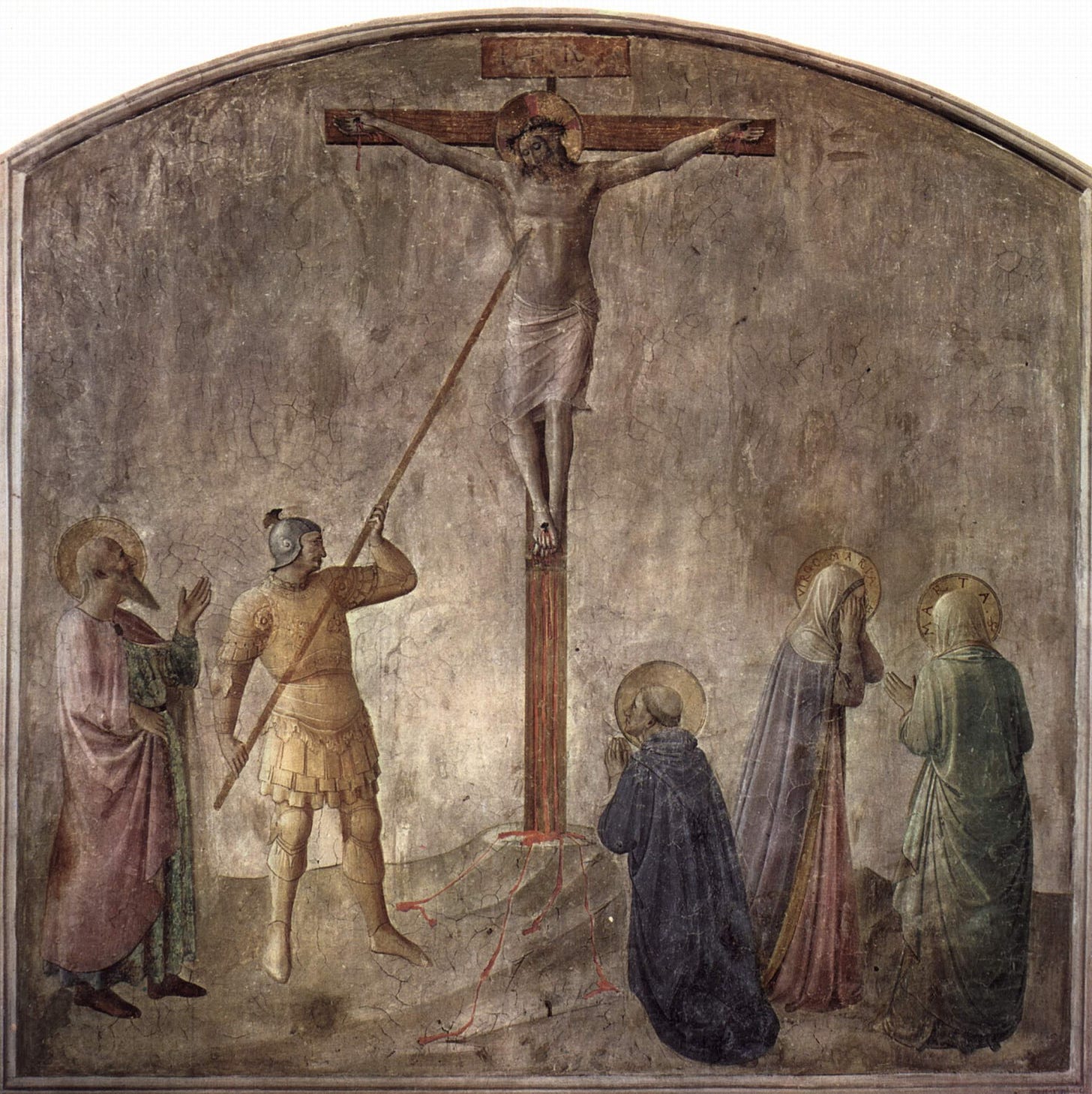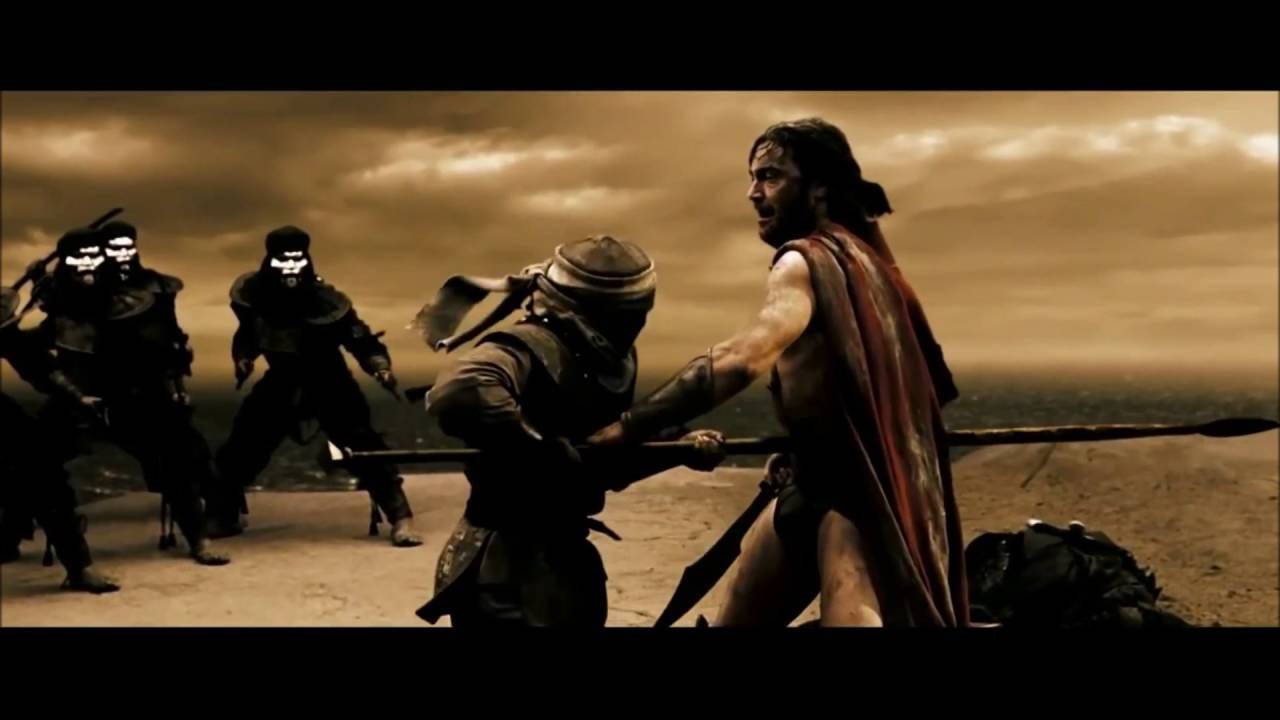Quick note before we get started. This post focuses on a visceral subject, but it’s not about endurance. I fell down a rabbit hole, and rather than pull myself out, I decided to go deeper.
We’ll be investigating the cinematic origins of a violent film trope. It’s an over-the-top, borderline silly act, but a violent one nonetheless. So if that’s not your jam, skip this one. We’ll be back with more pacific pondering next time.
Opening jab
There is a recurring movie trope involving death with a spear: a character is stabbed, but before dying, they drag themselves up the shaft of the spear to deliver one final blow to their enemy.
It’s a violent and outlandish maneuver, but surprisingly common in recent American cinema. The first time I noticed the spear trope, I was watching Zack Snyder’s interminable Batman v. Superman.
The second installment in the DC Extended Universe, Batman v. Superman was part of Warner Brothers’ super-hero response to the Marvel Cinematic Universe. Heavy with religious overtones, the film ends melodramatically with Superman speared on a sharp piece of bone growing grotesquely out of the arm of the Big Baddie. Yes, it’s weird; bear with me.
Here is how it plays out: a weakened Superman flies at the CGI villain, stabbing him with a kryptonite weapon. In so doing, Superman is himself harpooned on the sharp bone. In his dying moments, the Man of Steel pulls himself toward the monster, further impaling himself to deliver the coup de grace, vanquishing the villain and saving the day.
Variations on a thrust
Superman’s death by perforation is a spectacle and kinda badass (at least compared to how he went out in the comics). It’s certainly bizarre. But once you notice the trope, you’ll spot it in other films. Here are a few.
The Lord of the Rings: The Fellowship of the Ring concludes with Aragorn, a main character in Tolkien’s fantasy saga, scuffling with a beefy orc. The fight ends with Aragorn running the orc through with his sword. The monster pulls itself further down the blade, snarling to the end.
The end of 300, another Zak Snyder flick, features a Spartan warrior dragging himself down a spear to slash a few more Persian soldiers.
The skewering action isn’t limited to films set in times of swords and shields. In 2002’s Star Trek: Nemesis, the villain Shinzon, played by Tom Hardy festooned like an iridescent dom, is impaled on a pipe. He pulls himself down it for one final exchange with Captain Picard.
The spear trope isn’t limited to men.1 As recently as 2022’s Black Panther: Wakanda Forever, the character Shuri, played by Letitia Wright, is speared against a rock while wearing the mantle of the Black Panther. She shortens the spear with her panther claws and drags herself off it. Yeeps!
What in the world is going on here? Why does this trope, so oddly specific in its violence, pop up so frequently across action and adventure genres?
Finding the source
A bit of internet sleuthing led me to the trope’s earliest film reference, the 1981 epic fantasy, Excalibur.
This opulent retelling of Arthurian legend is an over-the-top armor & costume drama—critics called it “a medieval Star Wars”—with British thespians Helen Mirren, Nigel Terry, Liam Neeson, and Patrick Stewart.
In Excalibur’s final battle, Mordred, King Arthur’s evil half-son, impales the king with an insectoid-shaped spear. Arthur makes one final effort, dragging himself down the shaft to stab Mordred through chest.
Have we found the trope’s origins? Not quite. This over-stylized costume drama points us to the textual source material for the spear trope: a 15th-century collection of chivalric stories.
In Le Morte d’Arthur, first printed in 1485, Thomas Malory created the ur-text for modern iterations of Arthurian legend, solidifying the characters and stories of the Round Table knights that had circulated in French romances and medieval legend. It depicts Arthur and Mordred’s final clash at the Battle of Camlann in grotesque detail:
Then the king gat his spear in both his hands, and ran toward Sir Mordred, crying: Traitor, now is thy death-daycome. And when Sir Mordred heard Sir Arthur, he ran until him with his sword drawn in his hand. And there King Arthur smote Sir Mordred under the shield, with a foin of his spear, throughout the body, more than a fathom.
And when Sir Mordred felt that he had his death wound he thrust himself with the might that he had up to the bur of King Arthur's spear. And right so he smote his father Arthur, with his sword holden in both his hands, on the side of the head, that the sword pierced the helmet and the brain-pan, and therewithal Sir Mordred fell stark dead to the earth; and the noble Arthur fell in a swoon to the earth, and there he swooned ofttimes.

In Malory’s telling, it is Arthur with the spear and Mordred who shoves himself up the shaft. The film Excalibur swaps their places to make Arthur appear the stronger of the two knights, capable of grimacing through impaling to finish the fight.
Sharp origins
What inspired Malory to create this unsettlingly specific sequence of violence?
In Europe, spears’ original usage was hunting, often of boars. We can find the spear-shaft maneuver referenced as far back as 400 BCE. Around that time, the Greek philosopher and military leader Xenophon created a short treatise on hunting that advised caution when spearing a boar:
The enraged beast will come on, and but for the teeth of the blade, would shove himself forward along the shaft far enough to reach the man holding the spear.2
Well into the 15th century, hunting guides advised extreme caution when spearing boars. Gaston III, Count of Foix, advised providential support after spearing a boar. The hunter should “not for a moment relax his hold, and keep pushing until God or men come to his aid.”3
By the time Gaston III was writing, religious spear imagery was common. With the advent of the crusades, a flood of relics and religious items were taken westward, increasing cultural interest in the physical objects connected to Christ. Among these were several relics claimed to be pieces of the Lance of Longinus, the spear referenced in the book of John as having pierced the side of Jesus while on the cross.4

Such relics contributed to an effervescence of late medieval Christian religion and were prominent in everyday life when Malory was writing. Intensely parochial cults in villages and towns around England revolved around images, stained glass, and relics, providing metaphysical anchors for community mutual aid during sickness and death.5
The more formative influence was the dynastic fighting between would-be monarchs. Although Malory’s identity is unclear, some scholars found records of service of a Malory serving as a knight in the retinue of the Earl of Warwick during the siege of Calais. Additionally, he may have been charged with crimes of violent robbery during the chaos of the civil wars that shook England in the late 15th century. If true, Malory very well may have been familiar with the business end of a spear.
And thus an act of hunting and warfare mutated, weirdly, into English textual tradition and so on to the popular cinema of the late 20th century. A 15th-century flourish of medieval violence now depicted alongside supermen and spaceships.
Thanks for reading.
Weekly run
Breakfast Club meets every Thursday for an 8-mile run:
When and Where: 6:30am at Lake Temescal in Oakland, CA
Pace: ~7:00 to 7:40 pace with some hills
For updates, email Katie Klymko at katieklymko at gmail.com to join Breakfast Club’s WhatsApp chat. More info
For more local events, join our Strava club, East Bay Strava Runners
Thanks for reading. You can follow me on Notes, Strava, and what’s left of Twitter.
In perhaps the most psycho-sexual interpretation of the trope, 300’s sequel, 300: Rise of an Empire ends with Eva Green, playing Artemisia of Caria, Queen of the ancient Greek city-state Halicarnassus, yanking herself up a sword to give the protagonist a final brooding glare.
Xenophon, On Hunting, trans. E.C. Marchant (Harvard University Press, 1928), 10.6.
Gaston III, Phebus, des Déduits de la chasse des bêtes sauvages et des oiseaux de proie (Paris), 1509
One such relic is contained at Saint Peter’s Basilica in a loggia above a statue of Saint Longinus carved by Gian Lorenzo Bernini,
Eamon Duffy, The Stripping of the Altars: Traditional Religion in England 1400-1580 (New Haven: Yale University Press), 1992.











Mad props for noticing the trope in the first place and then for committing to dive into the rabbit hole. 👏🏽👏🏽👏🏽😀
...excalibur is a banger flick...great read here...they is certainly also something quite sexual I think about these prolonged slow "deaths" by a stabbing rod...but maybe i have read too much tawdry...